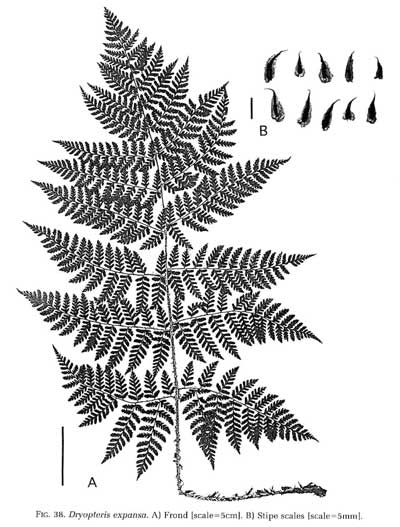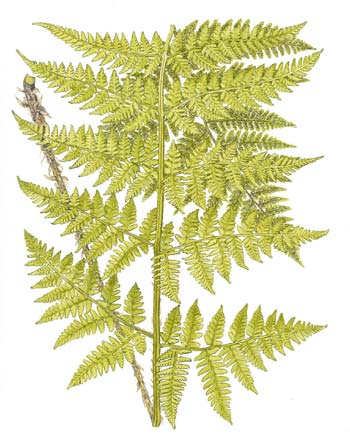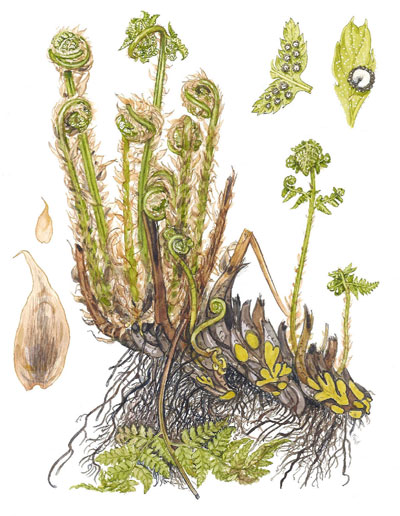| Dryopteris expansa | ||
Northern buckler fern, California barrel, northern wood fern, spinulose wood fern | ||
|
Etymology
expansa simply means expanded.
Description
Rhizome: erect, occasionally branching, covered in old stipe bases.
Frond: 80 cm high by 20 cm wide, tardily deciduous, monomorphic, blade/stipe ratio: 2:1. Stipe: grooved, scaly at least at base; scales scattered, brown with dark brown stripe, vascular bundles: 7 in a c-shaped pattern. Blade: 3-pinnate-pinnatifid, sometimes more at the base, deltate-ovate, slightly spreading to arching, herbaceous, yellowish-green, glabrous or with some glands. Pinnae: 12 to 14 pair, well spaced, the lowest usually curving upwards, anadromic; pinnules first lower pinnules on the lowest pinnae equal to or longer than adjacent pinnules, and twice the legth of the first upper pinnule; costae grooved above, continuous from rachis to costae, narrow scales on lower surface; segments fairly flat; margins serrate, spiny; veins free, forked. Sori: round, characteristically small, in 1 row between midrib and margin, but sparsely placed throughout the blade, indusium: reniform, at a sinus, sporangia: black, maturity: late summer. Culture
Habitat: cool moist woods and rocky slopes .
Distribution: Pacific rim, northern Europe, northeastern North America.
Hardy to -35�C, USDA Zone 3.
Distinctive Characteristics
basiscopic pinnule of the basal pinna is 2-3 times longer than the acroscopic one
Synonyms
Dryopteris assimilis S. Walker Dryopteris dilatata (Hoffm.) A. Gray misapplied Nephrodium expansum C. Presl Dryopteris dilatata (Hoffmann) A. Gray subsp. americana (Fischer) Hult�n |
|
|
Notes
Compare to Very similar to D. campyloptera. Fronds erect to slightly arching versus wide spreading in D. campyloptera. The basiscopic pinnule of the basal pinna is only 2-3 times longer than the acroscopic one, and the stipe scales may have a darker broad , central stripe rather than a darker area at the base in D. campyloptera, but both may have this latter feature. D. expansa is similar to D. dilatata, differing from the latter in being 3-pinnate-pinnatifid at the base rather than 3-pinnate. It also has lighter scales and the margins do not curve under.
Compare to Very similar to D. campyloptera. Fronds erect to slightly arching versus wide spreading in D. campyloptera. The basiscopic pinnule of the basal pinna is only 2-3 times longer than the acroscopic one, and the stipe scales may have a darker broad , central stripe rather than a darker area at the base in D. campyloptera, but both may have this latter feature. D. expansa is similar to D. dilatata, differing from the latter in being 3-pinnate-pinnatifid at the base rather than 3-pinnate. It also has lighter scales and the margins do not curve under.

Dryopteris expansa. �Illustration from The Cultivated Species of the Fern Genus Dryopteris in the United States, Barbara Joe Hoshizaki and Kenneth A. Wilson, American Fern Journal, 89, 1, (1999), with permission. |

Dryopteris expansa. Frond. �Illustration from Scandinavian Ferns by Benjamin �llgaard and Kirsten Tind, Rhodos, 1993. |

Dryopteris expansa. a) lowest pinnae strongly anadromic, note relative sizes of the pinnules; b) fertile pinnule, spiny. �Illustration by V. Fulford from Ferns and Fern Allies of Canada, William J. Cody and Donald M. Britton, 1989, � Agriculture Canada, used with permission. |
